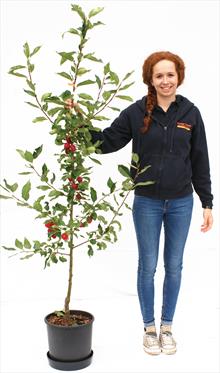Pink Glow
Malus baccataMalus 'Pink Glow' (also known as Malus 'Dolgo'), is named for its elongated dusky pink fruits, which form in plum-like clusters in September. The fruit is on the larger size for a crab apple, making it easy to use in the kitchen - it is perfect for crab apple jelly and a good source of pectin for other fruit jellies.
The blossom is plain white but borne in profusion early in the apple-blossom season. Pink Glow an excellent pollinator for all early-flowering apple varieties (those in flowering groups 1 and 2).
Our 2-year Pink Glow trees will usually produce blossom in the first spring after planting.
Pink Glow crab-apple trees for sale

All our pot-grown trees are grown for us to our specification by the Frank P Matthews nursery.
All pot-grown trees are suitable for planting out in the garden, some are suitable for growing in containers.
12-year pot-grown
tree
£61.00
Grown for us by Frank P Matthews nursery
In a 11.5L pot
Very small size (< 1.5m after 10 years)
22-year pot-grown
tree
£61.00
Grown for us by Frank P Matthews nursery
In a 12L pot
Medium size (2.5m-3.5m after 10 years)
Out of stock
Sorry we have sold out for this season
Next deliveries
Order now for delivery from 24th April.
How to grow
'Pink Glow' is easy to grow, largely disease-free. It originates from Russia and is exceptionally cold-hardy. It is popular with growers in Alaska where winter temperatures below -30C are not unusual, and is sometimes used as a cold-hardy rootstock for other less hardy varieties.
It is one of the better crab-apples for growing in patio-containers.
History
Malus 'Pink Glow' is also widely known as Malus 'Dolgo'. It is a member of the species Malus baccata, also known as the Siberian crab, but the fruitlets are considerably larger. It was discovered in the Imperial Botanical Gardens at St. Petersburg, Russia, at the end of the 19th century by American plant explorer N.E. Hansen. It was trialled by him at the South Dakota State University Agricultural Experiment Station, where its excellent cold-hardiness was quickly recognised. He named it Malus 'Dolgo' in 1917.
Pink Glow characteristics
- Gardening skillBeginner
- Attractive featuresAttractive flowersAttractive fruitAttractive tree / plantScented flowers
- Growth habitUpright-spreading / Vase
- Height after 10 years2.5m-3.5m / 8ft-12ft
- Growth rateAverage
- WildlifeAttractive to birds - Deer.RHS Plants for Pollinators
- Flower colourWhite
- Leaf colourGreen
- Fruit persistenceNormal ripening
- Food usesJam / Jelly
- Country of originRussiaUnited States
- Annual cycleDeciduous
Similar varieties
MalusJohn DownieAnother good variety for crab-apple jelly.
Malus baccataMalus baccataThe Siberian crab-apple, noted for its exceptional cold-hardiness, disease-resistance, attractive blossom and clusters of cherry-like fruitlets in autumn,
What will it look like?
Illustrative example of a pot-grown tree of this variety as supplied.
Approximate girth: 6/8cm. We try to keep all pot-grown trees down to about 1.5m as supplied, but some may be larger.
Trees should reach their mature height after about 10 or more years.

How to choose a crab-apple tree
We list more than 40 different crab-apple trees. Choosing can be difficult! See our article explaining the different characteristics of crab-apple trees which will help you narrow down the selection.
 Over 400 varieties of flowering cherries, crab apples, rowans and other ornamental trees.
Over 400 varieties of flowering cherries, crab apples, rowans and other ornamental trees.